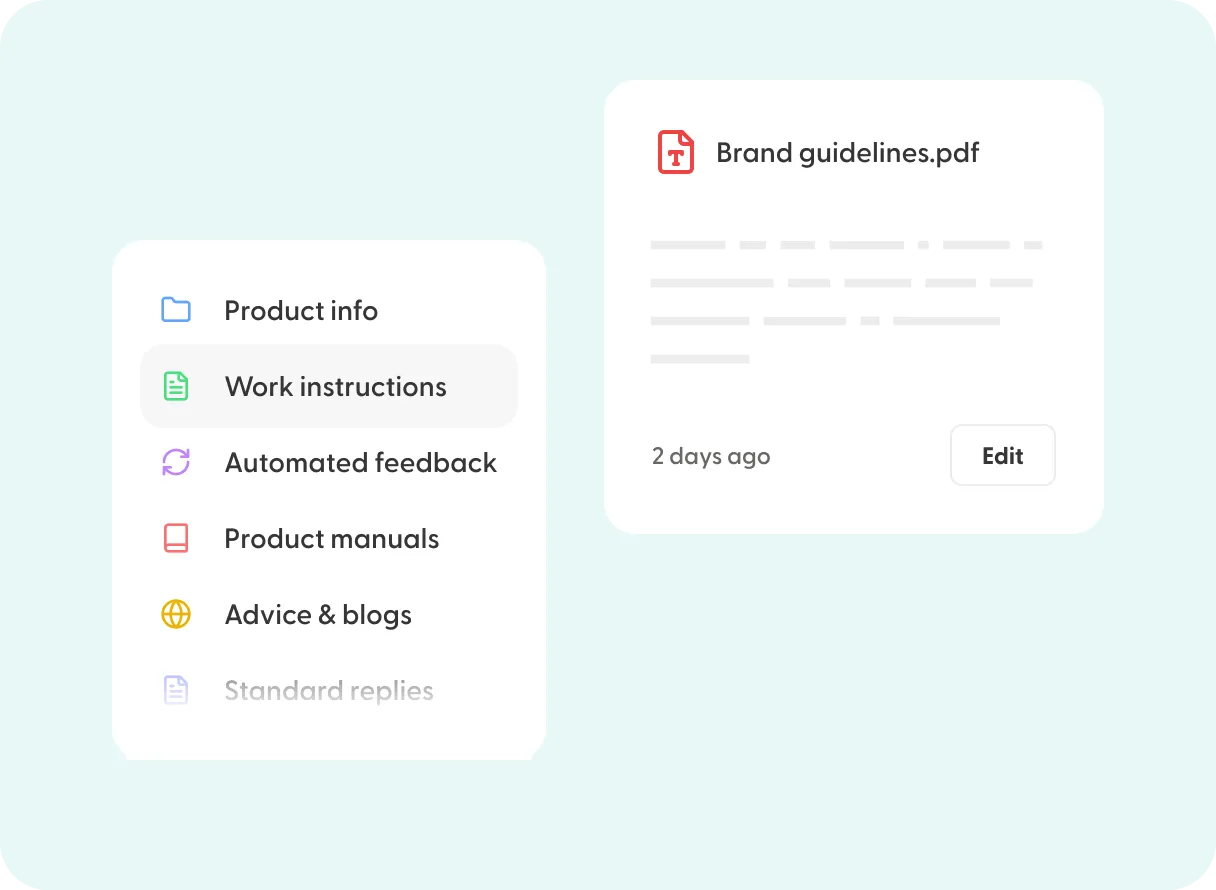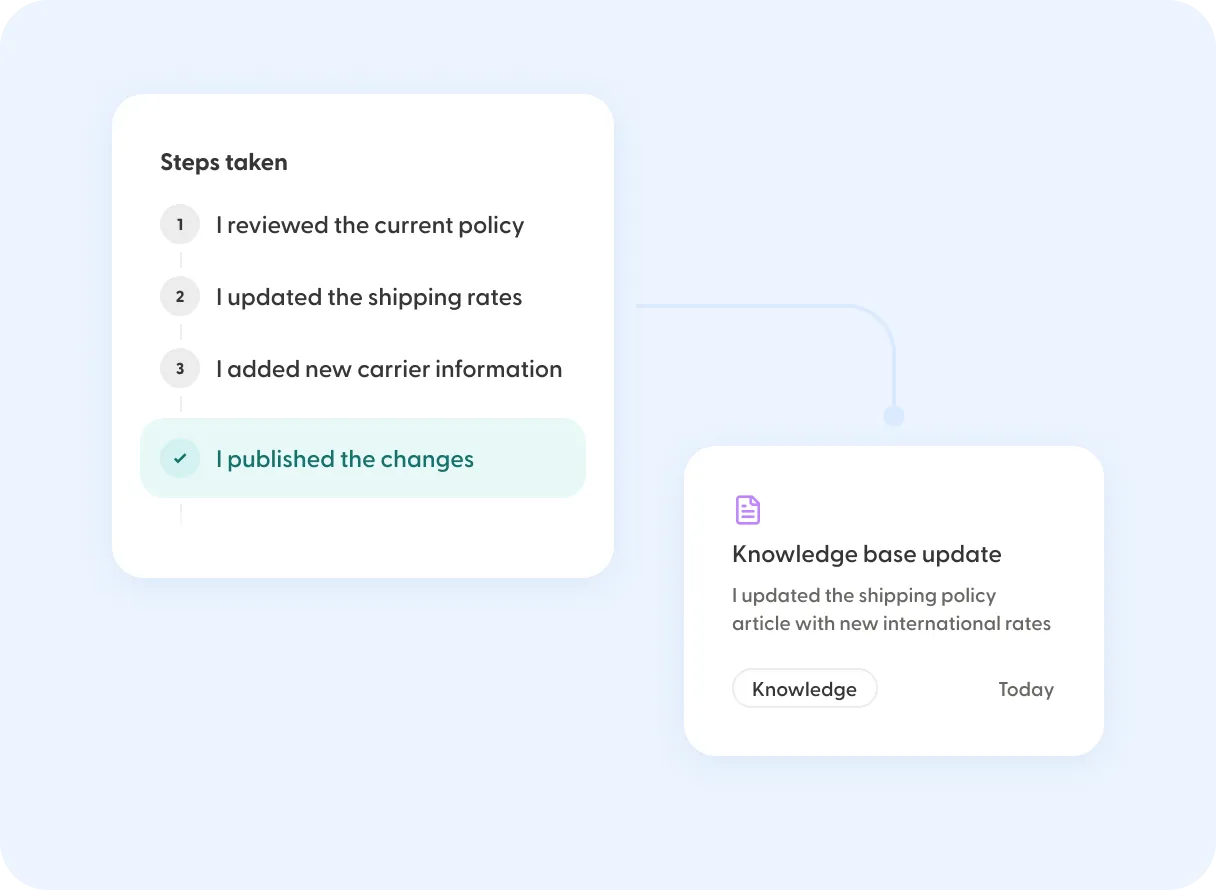
Support AI promises a lot. Faster resolutions, reduced pressure on your team, and a better experience for your customers. But too often, what you get is an AI agent that sounds robotic or a complicated workflow and decisions you can’t trace or even change.
Why? Because most AI solutions act like a black box. You see the AI’s output, but not the logic behind it. It’s time for a change. We’re sharing the ins and outs to take control of AI to improve customer support.
Why support AI often disappoints and what to do about it
You’re most likely considering AI in customer service to make your team faster, more consistent, and less overwhelmed. But in reality, it often adds new problems such as unclear decision logic, off-brand tone, or wrong responses. The root cause? Most teams can’t actually see or shape how their AI agents work. This article breaks down the five areas that matter most, and how to take back control.
No time to read through all the details? Here’s your TL;DR. Make sure to get visibility across five areas to nail support AI:
- Tasks: Structure and preview exactly what your AI does, so you can ensure it handles tickets the way your team would.
- Tone: Ensure responses sound on-brand and human, helping customers feel understood, not brushed off by a bot.
- Logic: Understand and influence how decisions are made (and why), so you can troubleshoot issues and build trust in your AI’s actions.
- Feedback loops: Continuously improve output based on real insights, so your AI gets smarter, faster, and more useful over time.
- Analytics: Track team adoption, performance, and feedback in real-time, so you can make data-driven decisions and measure ROI.
Want to know more about how this exactly works? Continue reading as we’re sharing all the details below.
The promise and pitfalls of AI in customer support
If done right, support AI can boost efficiency, reduce workload, and improve customer satisfaction. But if you skip the foundations, it can quickly backfire. Before looking into the how, let’s take a closer look at what’s at stake.
The benefits when AI works well
- Faster response times: For common queries like refunds, delays, and FAQs, which helps to reduce boring and repetitive work.
- Lower pressure on your team: Especially during peak seasons, so agents can focus on complex or sensitive cases without burning out.
- Consistent answers across all channels and shifts: Ensuring your customers get the same quality experience every time, no matter who’s (virtually) on duty.
- Reduced churn and ticket escalations: Through proactive support, helping you resolve issues before they spiral and keep customers loyal.
- Better customer insights: Via feedback loops and performance tracking, so you can spot patterns, optimize workflows, and show a clear ROI.
The pitfalls when AI isn’t setup properly
- Unclear logic: You can’t explain why a chatbot or your AI solution said what it said, which can hurt internal trust and makes it hard to fix mistakes.
- Rigid tone of voice: Messages feel cold or robotic, damaging customer experience and increasing the risk of escalations.
- Outdated knowledge: AI pulls from the wrong SOP (Standard Operating Procedure) or docs, leading to misinformation, confusion, or even compliance issues.
- No feedback loop: Mistakes get repeated instead of fixed, which is bad for the overall quality and AI never improves over time.
- Slow updates: If AI is too complicated, you often need external help just to change a workflow or phrasing, which slows you down.
5 essentials to deliver high-quality AI support
Support AI shouldn’t feel like a black box. To get real value, your team needs visibility and control. They need to become AI superusers. The good news? You don’t need to be technical to become an AI superuser. By focusing on five key areas you can finetune how your AI works, improve outcomes, and build trust across everyone in your organization. Here’s what to look for in AI for customer support and how to implement it.
1. Clear, structured AI tasks and knowledge
Support AI should make workflows smarter, not messier. That starts by feeding AI with the right knowledge and breaking down tasks into distinct actions. Think of handling refunds, order updates, or policy questions. With clearly defined knowledge and tasks, you can:
- Make sure the correct information is used at all times to provide the best possible answers
- Build the right workflows to make sure AI performs tasks in the right way
- Ensure consistent action logic
- Identify what tasks should be automated, suggested, or handled by human agents
To structure AI tasks well you first need to map common support scenarios step by step. After that, define where AI should act independently and where it should suggest or escalate the issue to a human agent. You don’t want your team to become hesitant to use AI because it’s not set up properly. So make sure to test the AI’s performance using real examples before rolling it out to your team.
With Neople Studio, you can preview how your AI handles specific tasks, tweak the logic behind it, and assign your Neople to new tasks, all without writing a line of code.
“Our Neople helps us with keeping a human touch in our customer service, and on the other hand, it also helps us with automation and making our human agents' answers more efficient.” - Moritz Wahrlich, Head of Operations at Holy

2. On-brand, human tone of voice
If you want to deliver excellent customer experiences, speed and accuracy of an answer aren’t enough anymore. Customers expect friendly, helpful, and timely service from every brand they purchase from. So when you’re using AI, you need it to sound like a real person who’s part of your team, and not like a cold or robotic chatbot.
With your tone of voice you can give your brand a personality, which also benefits AI. Your tone of voice helps customers feel recognized, reassured, and respected, especially during moments of friction or frustration.
When your AI nails the tone, you can:
- Stay consistent across team members during different work shifts, channels, and even languages
- Build familiarity that makes your brand more memorable
- Create predictability and trust in automated interactions
- Improve productivity of your customer support team, without losing the human touch
To make sure your AI agent sounds like your human agens, start by building a tone of voice guide that includes your brand values, personality traits, and messaging dos and don’ts. Include tone variations for different scenarios (e.g. refunds vs. complaints), sample phrases, and empathy guidelines.
Then, train your AI on real-life examples from your own customer conversations, and keep iterating based on feedback from your team and customers.
With Neople Studio, your tone of voice isn’t locked in an onboarding doc that can never be changed. Instead, you can edit tone settings directly inside your Neople’s employment information at any time, and instantly see the impact in your live messages.
3. Transparent decision logic
One of the biggest blockers to your employees trusting AI is not knowing why it gave a certain answer. When logic is unclear, your team ends up second-guessing, or worse, re-doing the AI’s work. That defeats the purpose.
When the AI’s decision logic is transparent, you can:
- Understand the reasoning behind every decision
- Identify and fix gaps in knowledge or rules
- Build internal trust in automation and reduce escalation of issues to human agents
To improve your AI’s decision logic, map out the inputs (customer question, intent), references (docs, SOPs), and outputs (the answer). Check if the AI followed a rule, pulled from a specific document, or made an assumption. Use that data to refine how the AI operates so that it makes better decisions in the future.
Neople Studio makes every step traceable by showing which knowledge, rules, or logic your Neople used. This way you always know how an answer was formed.

4. Real-time feedback loops
To get better, AI needs regular, real-time feedback. Without a feedback loop in place, mistakes become patterns and your team ends up correcting the same issues over and over, and trust in your AI fades.
A strong feedback loop lets you flag errors and improve responses instantly. It also helps to monitor usage, outcomes and gaps in logic. And what about spotting recurring issues? Focus on the root cause to fix it for once and for all.
To start using feedback loops, build a system where agents can give quick feedback on AI suggestions or actions. Then review the flagged items regularly to update logic, documents, or tone. But feedback is only useful if it leads to changes in how the AI operates.
In Neople Studio, every message can be rated, flagged, or improved in one click.
5. Integrated analytics to track and improve
Support AI isn’t a set-it-and-forget-it solution, it needs iteration to perform at its best and adapt as your products, team, and customer preferences evolve. To scale successfully, you need insights, not instincts. That’s where analytics come in. With the right data, your team can easily spot what’s working, what’s not, and where to improve the AI.
Here’s what data to regularly review:
- Adoption rates: How often is your team using the AI? Are they skipping it, overriding it, or relying on it more and more?
- Response accuracy: Are suggested answers getting accepted or edited? What’s the error rate per topic?
- Category performance: Which workflows are saving time, and which need refining?
- Customer feedback and CSAT scores: Are satisfaction scores improving? What’s the sentiment on AI-generated messages?
- Knowledge effectiveness: Which documents or SOPs are most referenced, and which might be outdated or unclear?
With Neople Studio, all of this is tracked and visible in a real-time dashboard. From usage reports to task-level breakdowns, you can drill into performance and make changes that actually move the needle.
Master support AI with Neople Studio to scale CS and boost satisfaction
If there’s one thing we’ve learned from working with support teams, it’s that the companies that get the most out of AI are the ones who treat it as a skill, not a shortcut. Employees that grow into AI superusers will outperform those who don’t. Neople Studio was built to help your team do exactly that. Here are six reasons why it pays off:
- Full visibility into AI behavior: Trace every action your AI takes, from logic to source, so you can understand and improve decisions. This results in fewer mistakes, faster fixes and more satisfied customers.
- Self-sufficiency & control: Update documents, workflows, and tone of voice instantly without outside help. It’ll lead to faster iterations and more agility.
- AI literacy & superuser onboarding: Learn by doing with access to live tasks, feedback, and analytics. This enables non-technical team members to automate the repetitive tasks and focus on delivering proactive support or handling edge cases.
- Integrated analytics for performance tracking: Monitor usage, outcomes, and opportunities to improve your AI to deliver better customer experiences.
- Customization and brand alignment: Make your Neople sound like your brand with a customizable tone of voice that also sounds human. It’ll help you to automate workflows and respond to incoming inquiries while keeping a strong customer connection.
- Better customer experience and reduced risk: Deliver faster, more accurate, and more human support. This will help you get happier customers and fewer escalations.
We can say Neople’s great, but our customers’ experience is what really matters, right? Here's what Pam van Nuland, Webshop Coordinator at Shoeby says about working with their Neople Scotty:
"Scotty provides fresh and surprising responses, ensuring that customer service agents don’t get stuck in repetitive interactions."
Curious to see Neople Studio live in action or do you want to learn more about how a Neople can help you increase customer satisfaction while scaling support? Book a free demo, in 30 minutes we’ll show you how a Neople can work in any of your workflows.
.png)
.jpg)





.webp)